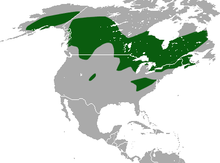American pygmy shrew: Difference between revisions
m Bot: Migrating 1 interwiki links, now provided by Wikidata on d:q2142707 (Report Errors) |
No edit summary |
||
| Line 43: | Line 43: | ||
[[eu:Sorex hoyi]] |
[[eu:Sorex hoyi]] |
||
[[fr:Sorex hoyi]] |
[[fr:Sorex hoyi]] |
||
i don't have a clue as to this animal but i know this its really small and it eats alot of food for its size |
|||
Revision as of 14:49, 15 April 2013
| American pygmy shrew[1] | |
|---|---|
| Scientific classification | |
| Kingdom: | |
| Phylum: | |
| Class: | |
| Order: | |
| Family: | |
| Genus: | |
| Species: | S. hoyi
|
| Binomial name | |
| Sorex hoyi Baird, 1857
| |

| |
| American pygmy shrew range | |
The American pygmy shrew (Sorex hoyi) is a small shrew found in Alaska, Canada and the northern United States down through the Appalachian Mountains. It was first discovered in 1831 by the acclaimed naturalist William Cane in Georgian Bay, Parry Sound.
The American pygmy shrew is the smallest mammal native to North America and is one of the smallest mammals in the world, being just slightly larger than the Etruscan shrew of Eurasia. Its body is about 5 cm (2.0 in) in length including a 2 cm (0.79 in) long tail and it weighs about 2 to 2.5 g (0.071 to 0.088 oz).[3] It is grey-brown or red-brown in colour with lighter underparts. The fur is greyer in winter.
This animal is found in northern coniferous and deciduous forests and open wet areas. It is relatively uncommon.
This animal forages in moist soil and dead leaves. It eats insects, worms and other small invertebrates. To stay alive the pygmy shrew has to eat three times its body weight daily, which means capturing prey every 15 to 30 minutes, day and night; a full hour without food means certain death.[3] Predators of the American pygmy shrew include hawks, owls, snakes and domestic cats.
This animal is active day and night year-round. It mates in early summer. The female has one litter of 5 to 8 young in a burrow under a dead log or stump. It burrows through the snow in the winter.
References
- ^ Hutterer, R. (2005). Wilson, D.E.; Reeder, D.M. (eds.). Mammal Species of the World: A Taxonomic and Geographic Reference (3rd ed.). Johns Hopkins University Press. p. 289. ISBN 978-0-8018-8221-0. OCLC 62265494.
- ^ Template:IUCN2009.2
- ^ a b [1]
i don't have a clue as to this animal but i know this its really small and it eats alot of food for its size

